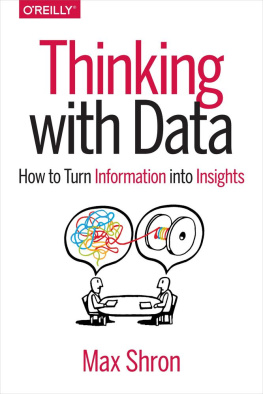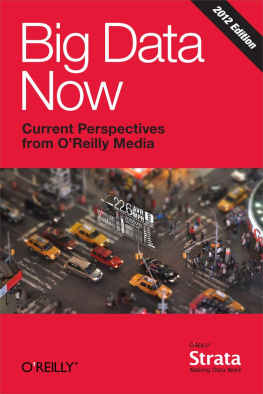Turning Data into Wisdom
How We Can Collaborate with Data to Change Ourselves, Our Organizations, and Even the World
www.turningdataintowisdom.com
2020 Kevin Hanegan
All Rights Reserved.
No part of this book may be reproduced in any form or by any meanselectronic, mechanical, digital, photocopying, or recordingexcept for the inclusion in a review, without permission in writing from the author.
First edition.
ISBN: 978-0-578-63987-1
Editor: Andrea Barilla, www.andreabarilla.com
Cover Design: JD&J Book Cover Design, www.jdandj.com
Book Interior: Robin Krauss, Book Formatters, www.bookformatters.com
Introduction
G rowing up, I often heard sayings like dont judge a book by its cover and there are two sides to every story that I didnt really believe and just thought were clich. At that point, I thought I knew everything there was to know, but in reality, I knew very little about anything.
As I grew older, I studied math and statistics in school and was taught there is only one answer to a given problem. Whether it was a calculation, the truth value of a statement for a theorem, or something else, there was always only one right answer. Everything was black and white.
Then, as I got older and had a family, I was presented with a challenge. My oldest son is autistic. Without going into much detail, it can be very frustrating because the way he looks at the world and perceives things is very different than how I perceive things or how other kids perceive things. To him, the world is just like we are taught in math and statistics: black or white, right or wrong, true or false. There is no room for interpretation, and there are not multiple sides to every story.
Eventually, I started diving more into data literacy and had a realization. Each data point, bit of evidence, or observation is a piece of a greater puzzle. There is a story there waiting to be unlocked. Yes, the value of a point of data may be the number two or the color yellow, but what does that really mean, and what can we do with that information? This ties to the concept of data-informed decision-making. A single data point, bit of evidence, or observation is one-dimensional. However, when you start to combine data together, you are starting to put the pieces of the puzzle together. Then, when you add in your experiences and beliefs along with the experiences and beliefs of others, the data starts to come to life and tell you a storya story that can give you great wisdom and insights. This is one reason why decision-making should celebrate diversity and inclusion and be a team sport, as these different perspectives allow you to see multiple sides of the data and what its story is.
With that realization and gained wisdom, I started to apply this thinking to my son. I stopped looking at his attitudes and behaviors as wrong. Just like with data, there is a story there and a puzzle that was waiting to be put together. I just needed to put aside my bias and try to understand his side of the story based on his experiences and beliefs.
My goal now is to continually educate him on different perspectives in the hope he will be well rounded and cultured one day and see that the world is not black and white. While this has not been a total success yet, the tenets in data literacy are the same ones I now apply to him. I am always curious why he believes what he believes and why he does what he does. I challenge him often, and I ask him sometimes to think through his thought process so that I can hear his perspective. In many cases, I have left the conversation realizing it was I who had tunnel vision and bias, not him. This practice with my son has opened up an entirely new world of collaboration between us, and I have a ton more wisdom than I did before as a result.
Lets go back to data for a second. In business, we should not think like we did back in school that there is only one right answer when it comes to data and analytics . Your experiences combined with others experiences will allow you to turn that data into insights and wisdom that will continue to help businesses, society, and our planet. Continue to be curious about the data, and challenge it. Try to find ways to disprove your assumptions and beliefs rather than looking to justify them. And, just like I now celebrate my sons diversity and unique perspectives, I also preach that businesses should do the same when they are making decisions. Seeking diverse perspectives will help you understand the different sides and stories data can tell, and it can truly change the world by helping you make more-informed decisions.
This book provides a six-phase process and a twelve-step methodology to follow regarding how you can take data and apply the perspectives of yourself and others to make data-informed decisions. Investments in data strategy and analytics will be uselessand can even be harmfulunless individuals and organizations can leverage anthropological skills and understand behaviors and psychology to provide the right context for the data (in addition to the more technical skills around data and analytics).
Therefore, this book and the process and methodology described within it are a combination of multiple areas, including analytics, psychology, anthropology, and enterprise thinking.
This book can be used by anyone who needs to make decisions at any level of an organization. The data-informed decision-making process is iterative and not linear, and different types of decisions may require different parts of the steps or different tools within each step. Therefore, there are a wide range of tools and models discussed in this book. The tools and models are not discussed in any great length, as entire books can be and are devoted to them. Instead, think of them as a tool kit you can pull from when making decisions.
I hope you enjoy this book, and, more importantly, I hope that you receive the same value from the knowledge within it that I have received over the years.
CHAPTER 1
The Power and Potential of Data
Were entering a new world in which data may be more important than software.
Tim OReilly
W e are living in a truly unprecedented timeone that is radically changing the way we work, the way we live, and the way we communicate with each other. This is the dawn of the fourth industrial revolution.
The first industrial revolution used coal and water to make steam to mechanize. The second industrial revolution used electricity to mass-mechanize and mass-produce. The third industrial revolution leveraged electricity to bring about the rise of electronics, both to miniaturize (microprocessors) and automate (automatons and robots). The fourth industrial revolution (a term coined by economist Klaus Schwab and the title of his book of the same name) includes technology breakthroughs like machine learning, IoT, 3D printing, nanotechnology, biotechnology, and energy storage. And what powers all of this? Data. Need more proof of the value data will play? The market intelligence firm International Data Corporation (IDC) predicts that by 2027, data will be something that can be valued on a companys balance sheet.











